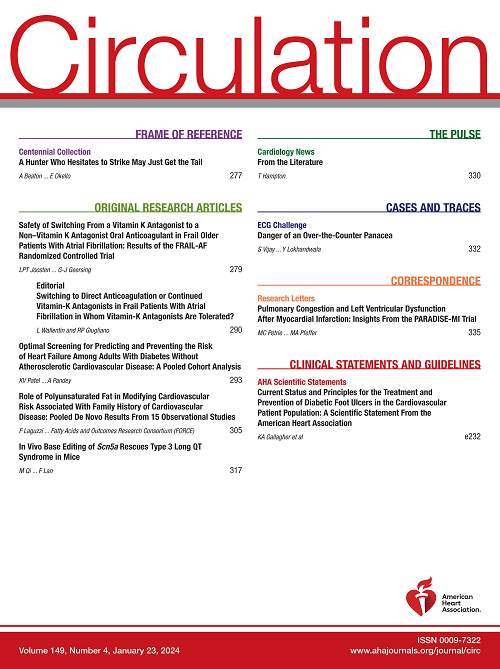脉冲场消融治疗阵发性心房颤动:ADMIRE 关键性试验的安全性和有效性。
IF 35.5
1区 医学
Q1 CARDIAC & CARDIOVASCULAR SYSTEMS
引用次数: 0
摘要
背景早期脉冲场消融(PFA)系统治疗心房颤动的临床试验证据表明,该系统在保持疗效的同时,有望减少与传统热疗模式相关的并发症。然而,由于缺乏完全集成的映射系统(大多数现代电生理学手术的主要技术),病灶创建和工作流程选择受到了限制。新开发的可变环路 PFA 导管与电解剖映射系统集成,可实现实时的非荧光手术引导和病灶索引,以及组织与导管接近度的反馈。ADMIRE(博森-韦伯斯特不可逆电穿孔消融系统治疗心房颤动安全性和有效性评估)是一项多中心、单臂、食品药品管理局研究性设备豁免研究,评估了这一集成 PFA 系统在美国大型药物难治性症状性阵发性心房颤动患者群体中的长期安全性和有效性。方法Using the PFA catheter with a compatible electroanatomic mapping system, patients with drug-refractory symptomatic paroxysmal atrial fibrillation undergone pulmonary vein isolation.主要安全性终点是消融术后 7 天内的主要不良事件。主要有效性终点为综合终点,包括12个月内无房性快速性心律失常(即房颤、房性心动过速、心房扑动)发作、未能实现肺静脉隔离、使用非研究导管进行肺静脉隔离、重复手术(空白期重做一次除外)、空白期后服用新的或之前失败的 I 类或 III 类抗心律失常药物(剂量更大),或空白期后进行直流电心脏复律。结果30个中心的277名阵发性心房颤动患者(61.5±10.3岁;64.3%为男性)接受了PFA治疗。25%以上的手术在无透视的情况下进行。肺静脉隔离手术、透视和转位 PFA 应用时间的中位数(Q1、Q3)分别为 81.0(61.0、112.0)分钟、7.1(0.00、14.3)分钟和 31.0(24.8、40.9)分钟。主要不良事件发生率为 2.9%(272 例中有 8 例),最常见的并发症是心包填塞。12 个月的主要有效性终点为 74.6%。空白对照后,心房颤动、房性心动过速或心房扑动的1年复发率为75.4%。结论ADMIRE证实了可变环路PFA导管的安全性和有效性,手术和PFA应用时间短,透视暴露低。REGISTRATIONURL: https://www.clinicaltrials.gov; Unique identifier:NCT05293639。本文章由计算机程序翻译,如有差异,请以英文原文为准。
Pulsed Field Ablation to Treat Paroxysmal Atrial Fibrillation: Safety and Effectiveness in the ADMIRE Pivotal Trial.
BACKGROUND
Evidence from clinical trials of early pulsed field ablation (PFA) systems in treating atrial fibrillation has demonstrated their promising potential to reduce complications associated with conventional thermal modalities while maintaining efficacy. However, the lack of a fully integrated mapping system, a staple technology of most modern electrophysiology procedures, poses limitations in lesion creation and workflow options. A novel variable-loop PFA catheter integrated with an electroanatomic mapping system has been developed that allows for real-time nonfluoroscopic procedural guidance and lesion indexing as well as feedback of tissue-to-catheter proximity. ADMIRE (Assessment of Safety and Effectiveness in Treatment Management of Atrial Fibrillation With the Bosense-Webster Irreversible Electroporation Ablation System), a multicenter, single-arm, Food and Drug Administration investigational device exemption study, evaluated the long-term safety and effectiveness of this integrated PFA system in a large United States-based drug-refractory symptomatic paroxysmal atrial fibrillation patient population.
METHODS
Using the PFA catheter with a compatible electroanatomic mapping system, patients with drug-refractory symptomatic paroxysmal atrial fibrillation underwent pulmonary vein isolation. The primary safety end point was primary adverse event within 7 days of ablation. The primary effectiveness end point was a composite end point that included 12-month freedom from documented atrial tachyarrhythmia (ie, atrial fibrillation, atrial tachycardia, atrial flutter) episodes, failure to achieve pulmonary vein isolation, use of a nonstudy catheter for pulmonary vein isolation, repeat procedure (except for one redo during blanking), taking a new or previously failed class I or III antiarrhythmic drug at higher dose after blanking, or direct current cardioversion after blanking.
RESULTS
At 30 centers, 277 patients with paroxysmal atrial fibrillation (61.5±10.3 years of age; 64.3% male) in the pivotal cohort underwent PFA. More than 25% of the procedures were performed without fluoroscopy. Median (Q1, Q3) pulmonary vein isolation procedure, fluoroscopy, and transpired PFA application times were 81.0 (61.0, 112.0), 7.1 (0.00, 14.3), and 31.0 (24.8, 40.9) minutes, respectively. The primary adverse event rate was 2.9% (8 of 272), with the most common complication being pericardial tamponade. The 12-month primary effectiveness end point was 74.6%. The 1-year freedom from atrial fibrillation, atrial tachycardia, or atrial flutter recurrence rate after blanking was 75.4%. Substantial improvements in quality of life were observed as early as 3 months after the procedure, concurrent with a reduction in multiple health care use measures.
CONCLUSIONS
ADMIRE confirmed the safety and effectiveness of the variable-loop PFA catheter, with short procedure and PFA application times and low fluoroscopy exposure.
REGISTRATION
URL: https://www.clinicaltrials.gov; Unique identifier: NCT05293639.
求助全文
通过发布文献求助,成功后即可免费获取论文全文。
去求助
来源期刊

Circulation
医学-外周血管病
CiteScore
45.70
自引率
2.10%
发文量
1473
审稿时长
2 months
期刊介绍:
Circulation is a platform that publishes a diverse range of content related to cardiovascular health and disease. This includes original research manuscripts, review articles, and other contributions spanning observational studies, clinical trials, epidemiology, health services, outcomes studies, and advancements in basic and translational research. The journal serves as a vital resource for professionals and researchers in the field of cardiovascular health, providing a comprehensive platform for disseminating knowledge and fostering advancements in the understanding and management of cardiovascular issues.
 求助内容:
求助内容: 应助结果提醒方式:
应助结果提醒方式:


